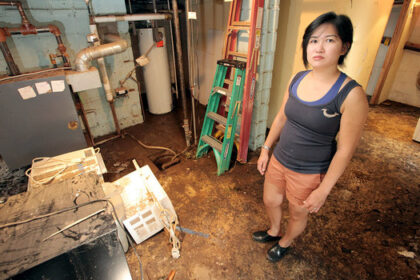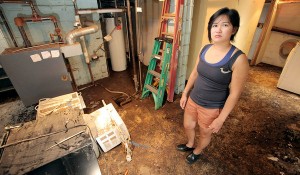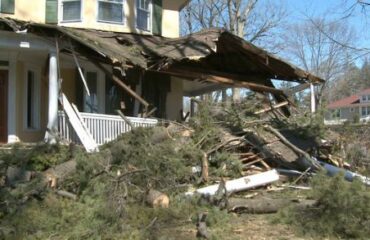
AFTER the shrewd and wary real estate blogger known as Grim (real name: James A. Bednar of njrereport.com) bought his first house last spring, he quickly announced where he would start with renovations: the damp basement.
Showing and telling with pictures on his blog — which up to then had concerned itself only with the vagaries of the market and how to get a deal — Mr. Bednar demonstrated to his hundreds of followers the “right way” to keep a basement dry.
He excavated dirt to eight inches below the foundation, laid down stones and drainpipes, applied flashing and asphalt coating to the foundation walls, insulated them with foam board, and then regraded the property with backfill.
This was three months before Tropical Storm Irene; did we mention Grim is shrewd?
Mr. Bednar’s basement did stay dry — although Wayne, which has many low-lying areas that are federally designated flood plains, was among the hardest-hit communities in the state. President Obama even stopped by Wayne (along with neighboring Paterson) to view the devastation and promise aid in rebuilding.
In the view of some worried brokers and agents, though, rebuilding buyer confidence in a piece of real estate, once it has gotten wet, may be beyond anyone’s powers.
“Anytime there is penetration — even seepage, even if only under extreme circumstances,” said Robert Lindsay, an agent at Coldwell Banker who has been selling houses in Wayne for 35 years, “it will affect property value.”
In Mr. Lindsay’s view, damage to buyers’ confidence in certain neighborhoods, or in specific houses affected by Irene, might take years to repair. “This is the hottest hot button there is for buyers,” he said. “People do tend to have short memories, but in this case, they figure, if it happens once, it can happen again.”
Right now, of course, extreme circumstances prevail — and buyers are probably “gun-shy” anyway, as Gary Large, the president-elect of the NJ Association of Realtors, put it. Mr. Large is also the Morris County manager for Prudential New Jersey Real Estate in Morristown.
In many towns in northern New Jersey that have high water tables, homes are generally equipped with sump pumps, and often battery backups, since home inspectors usually recommend them when buyers request a report on a home before purchase.
But sump pumps are not necessarily enough of a confidence booster in today’s climate, said Susan Hunter, the vice president of the Lois Schneider Realtor in Summit. One agent with her company had a closing scheduled for Aug. 30, two days after the storm. During the walk-through inspection, Ms. Hunter said, “the seller mentioned that for the first time in 30 years,” because of Irene, “there had been some minor seepage into one area of the basement.”
The buyer’s lawyer immediately insisted that money be put in escrow to cover the cost of repairs if the situation worsened.
Post-storm jitters have also been contagious among lenders, Ms. Hunter said. “Many banks are now requiring a ‘final inspection’ by the appraiser to inspect the home for storm damage before closing,” she said in an e-mail.
“We have already had a couple of closings delayed by this process,” she added. “Unfortunately it can cause a domino effect: if one buyer can’t close, the buyer for his house can’t close, and so on and so on.”
State real estate regulations require sellers to disclose whether a basement has ever been wet or damp, and to complete a disclosure form at the time a house is listed.
If sellers have not told the truth, and the basement floods after closing, “there is a viable potential for damages against the seller,” said Ken Baris, the president of the Jordan Baris agency in West Orange (where there was also widespread basement water damage from the storm).
One of Mr. Baris’s agents, Mary Louie, helped her daughter Frances Louie last year with the purchase of a three-bedroom home in Springfield on a street that lies within a flood plain.
“We knew it was a flood plain, obviously,” the younger Ms. Louie said. “We had to get flood insurance. But there have been a lot of big storms this year, and we never had flooding.”
Lenders require buyers in areas categorized as flood plains to obtain the insurance, which is available through theFederalEmergency Management Agency. On the Web site, floodsmart.gov, anyone can search whether risk of flooding for a given address is “low to moderate” or “high.”
“The neighbors said there have been floods,” Ms. Louie said in Irene’s aftermath, “but nothing ever this bad. There is mud all over the walls in our basement.” At that point she was still awaiting the arrival of cleanup workers from the town’s emergency management office.
Several of her neighbors who have paid off their mortgages had let flood insurance lapse — and at one house water had risen almost to the second floor. “I guess they have lost everything,” she said.
Mr. Lindsay recalled clients in the late ’90s who had bought a house near a flood plain, but not in it, who were not required to get flood insurance. That changed in 1999 after Hurricane Floyd, which caused extensive flooding in New Jersey. Federal authorities redrew the map to widen the flood plain and include the property.
“It was a kick in the shins,” Mr. Lindsay said. “Now the owners have to accept both the stigma and the cost, around $25,000 a year.”
When floodwaters entirely recede this time around, Mr. Lindsay said, he predicts that FEMA will again redraw its maps.
No matter the precautions taken, however, the surprise factor is always there, and Mr. Bednar, for all his hard work, was not exempt. “The basement was bone dry, not a drop of water,” he reported. “The chimney, however, let us down. In our defense, we didn’t get there with the renovations yet.”




